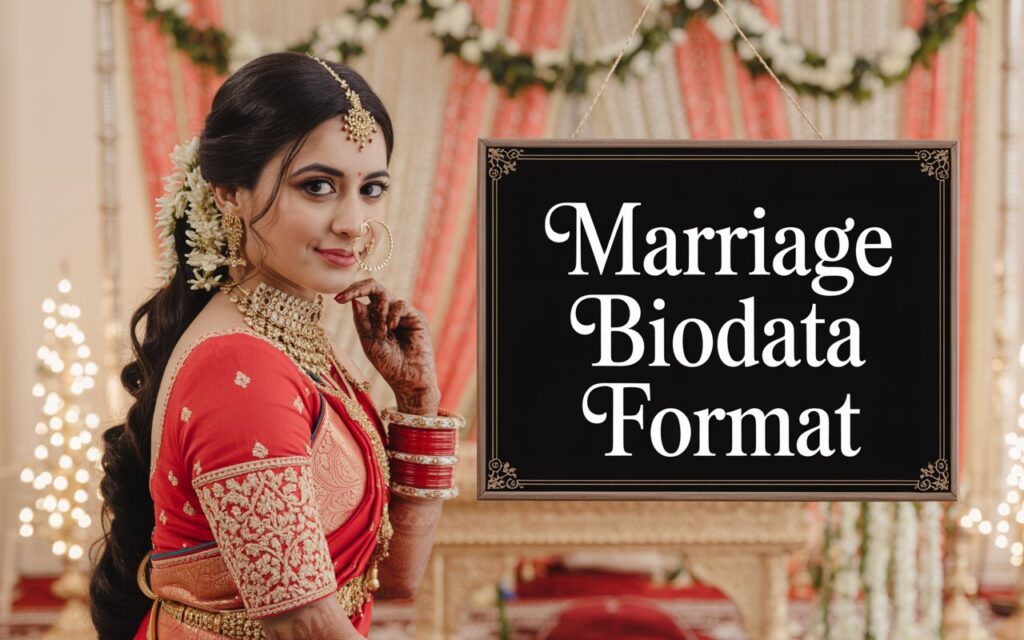In Indian matchmaking, the shadi biodata holds immense value. It’s often the first impression a prospective match and their family will have of you, which makes it vital to present yourself thoughtfully. A well-crafted biodata is more than a formal document—it’s a blend of personal identity, cultural relevance, and matrimonial readiness.
Whether you are preparing your first marriage profile or looking to redesign your existing one, this post will walk you through how to create a professional, appealing, and culturally appropriate shadi biodata format. You don’t need to be a designer or a writer to build one—just follow a few clear steps and understand what today’s families look for.
What is a Shadi Biodata Format?
A shadi biodata format is a structured document used primarily in arranged marriages across South Asia. It usually contains key personal information like name, age, religion, caste (if relevant), education, profession, family background, and preferences in a partner.
Unlike a resume used for jobs, this document focuses on compatibility, values, and lifestyle. Its design, tone, and layout reflect the seriousness of the intention behind it—marriage.
Why You Should Design Your Own Shadi Biodata
While you can easily find pre-made templates online, designing your own biodata ensures it truly reflects your identity. A personalized format allows you to highlight what matters most to you and your family. Also, you can control the tone—modern, traditional, or a perfect blend of both.
Customizing the layout also ensures your marriage biodata stands out among dozens of others. When families and potential matches review multiple biodatas, a clean and well-thought-out design can make yours memorable.
Core Elements to Include
Here’s a breakdown of what your shadi biodata should include:
1. Personal Details
Start with basic information such as:
-
Full Name
-
Date of Birth
-
Age
-
Height and Weight
-
Religion and Caste
-
Mother Tongue
-
Marital Status
-
Contact Information (yours or your family’s)
2. Educational Background
List your academic qualifications in reverse chronological order. Include institution names and degrees obtained.
3. Professional Information
Mention your job title, company, annual income, and location. For business owners or freelancers, explain your work briefly.
4. Family Background
Include details about your immediate family members, their occupations, and any relevant family values or cultural background.
5. Lifestyle and Hobbies
A few lines about how you spend your time, your interests, and values can make your profile more engaging.
6. Partner Preferences
Clearly mention expectations around age, religion, education, occupation, and cultural compatibility. This helps in filtering out incompatible matches.
Design Tips for Your Shadi Biodata Format
While content is king, presentation matters too. Use the tips below to design an attractive and organized format:
✅ Choose a Clear Layout
Keep information well-organized under headings. Use bullets or tables for readability. Avoid clutter.
✅ Keep It Short and Specific
Ideally, keep the biodata to one or two pages. Only include relevant information. Long essays are unnecessary.
✅ Use a Professional Font
Opt for clean, readable fonts like Calibri, Garamond, or Times New Roman. Font size should be between 11 and 12 points.
✅ Include a Recent Photograph
Add a clear, formal photo—preferably passport-size and high resolution. Place it on the top right or left.
✅ Add Soft Design Elements
Use subtle borders, pastel colors, or dividers to give a professional appearance. Avoid flashy or dark themes.
Digital or Print? Both Matter
Today, a lot of matchmaking happens online. So, it’s important to have both a digital and printable version of your biodata.
If you’re creating your marriage bio data online, make sure it’s saved as a high-quality PDF. This format preserves design and layout when shared through apps or websites.
If you’re printing it, ensure it’s printed on good quality paper with proper margins. Also, avoid over-designing; simplicity is classy.
Free Tools to Design Your Biodata
You don’t need expensive software to make a good-looking document. Here are some accessible tools you can use:
-
Canva – Offers ready-made templates for personal biodata and allows customization.
-
Microsoft Word – Great for simple formatting. Add tables and use alignment tools.
-
Google Docs – Cloud-based and easy to share.
-
Marriage-specific platforms – Many matrimonial websites offer built-in marriage biodata details sections. You can export them as PDFs.
Common Mistakes to Avoid
Even the most beautiful biodata fails if it contains basic errors. Watch out for:
-
Spelling or grammatical mistakes
-
Missing vital details like contact info or date of birth
-
Unclear partner preferences
-
Too much information—keep it to the point
-
Over-editing or flashy designs
Make It Match-Ready: Final Checklist
Before you begin sharing your biodata with families or matchmakers, check off this quick list:
-
All personal, educational, and professional details included
-
Photograph attached
-
Partner preferences clearly mentioned
-
Design clean and readable
-
Saved in PDF format for digital use
-
Printed copy available if needed
Simple, Effective, and Personalized
The beauty of a bio data for marriage simple format is that it’s adaptable. Whether you’re from a traditional family background or prefer a modern touch, the biodata can reflect your personality while serving its core purpose.
Adding small personal touches like a short quote or a meaningful motto can make it more appealing. However, ensure it remains respectful, informative, and sincere.
For example, instead of writing long stories, say something like:
“Family-oriented professional who values traditions, looking for a life partner with shared values.”
This small addition can make your simple biodata for marriage more expressive and genuine.
Conclusion
Designing your shadi biodata format doesn’t have to be a stressful task. With a clear structure, accurate content, and thoughtful design, you can present yourself confidently to potential matches and their families.
In a world where first impressions matter, your biodata is your story told on paper. Invest some time in making it sincere, neat, and well-formatted. After all, it could be the first step toward finding your life partner.
If you’re unsure where to begin, start with a simple draft. Review a few samples, use accessible tools, and always seek feedback from someone you trust. In no time, you’ll have a biodata that not only looks good but also represents you authentically.


